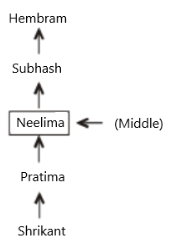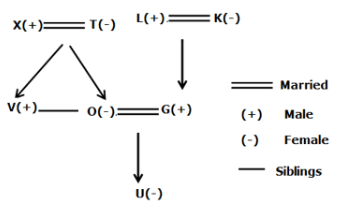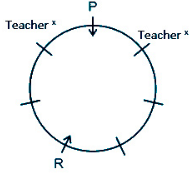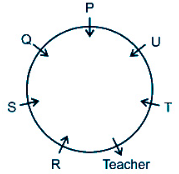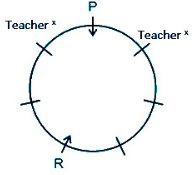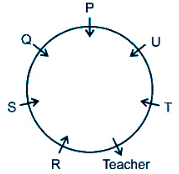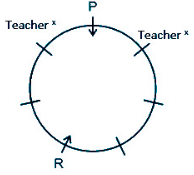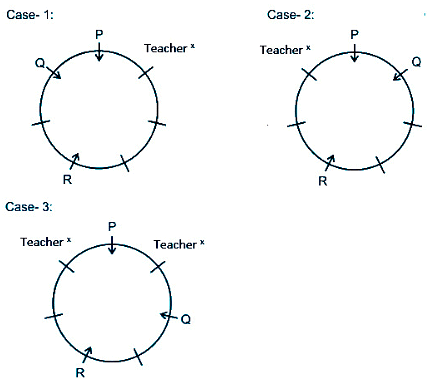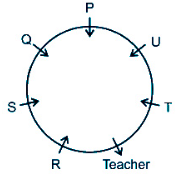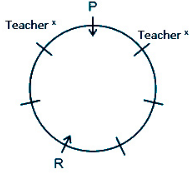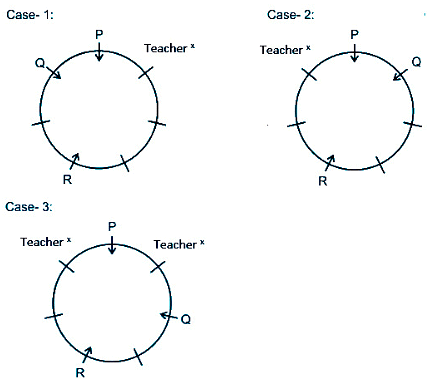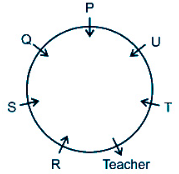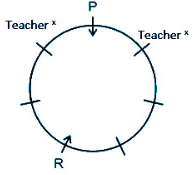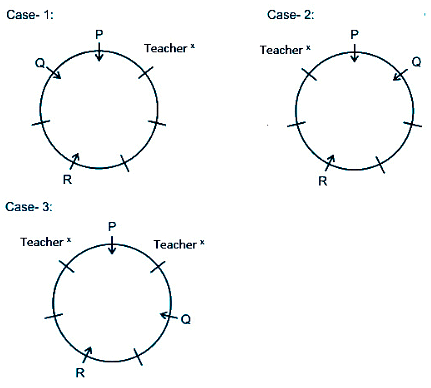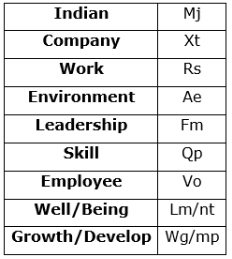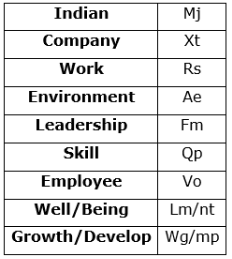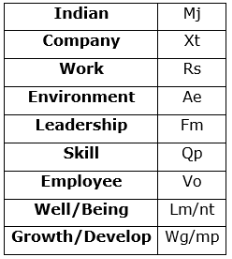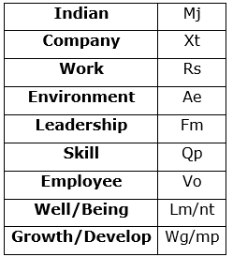IBPS RRB Clerk Prelims Mock Test - 1 - Bank Exams MCQ
30 Questions MCQ Test - IBPS RRB Clerk Prelims Mock Test - 1
If the letter of the words ‘FUTURISTIC’ are arranged in alphabetic order from left to right then what would be the third letter of the meaningful English word formed using third, fifth, sixth and eighth letter of the word formed after arranging? (If no word is formed mark ‘L’ as your answer and if more than one word are formed mark ‘M’ as your answer)
Study the following information carefully and answer the questions given below.
874 526 954 218 378 682
Q. If all the digits are arranged in ascending order within the number, then which of the following number is the third-highest number?
Study the following information carefully and answer the questions given below.
874 526 954 218 378 682
Q. If the first and third digits of each number are interchanged, then how many numbers are there between the highest and the lowest number in the final arrangement?
Study the following information carefully and answer the questions given below.
874 526 954 218 378 682
Q. How many numbers are divisible by 6 in the given series?
Study the following information carefully and answer the questions given below.
874 526 954 218 378 682
Q. If the first two digits are interchanged within the number and the numbers are arranged in ascending order from right to left, then which of the following number is second from the right end?
Study the following information and answer the question based on it.
(A) 'Srikanth' is younger than Neelima.
(B) Pratima is taller than Srikant.
(C) Subhash is taller than Neelima but shorter than Hembrum.
(D) 'Nilima' is taller than Pratima.
Q. If all of them are made to stand in a row in the order of their height, then who among them will be exactly in the middle of the row?
Direction: In the question below are given two statements followed by two conclusions numbered I and II. You have to take the given statements to be true even if they seem to be at variance with commonly known facts. Read all the conclusions and then decide which of the given conclusions logically follows from the given statements disregarding commonly known facts.
Statements:
Some books are papers.
Some papers are tables.
Conclusions:
I. Some books are tables.
II. No books are tables.
Direction: In the question below are given two statements followed by two conclusions numbered I and II. You have to take the given statements to be true even if they seem to be at variance with commonly known facts. Read all the conclusions and then decide which of the given conclusions logically follows from the given statements disregarding commonly known facts.
Statements:
Only a few dogs are cats.
All cats are tigers.
Conclusions:
I. All dogs are tigers.
II. Atleast some tigers are dogs.
Study the following information carefully and answer the below questions
A family consists of eight members- G, K, L, O, T, U, V and X and three married couples. X is the father-in-law of G who is the father of U. O is the only daughter of T who is the mother of V. T is the spouse of X. Both U and X are of the opposite gender. K is the mother-in-law of O. L is the paternal grandfather of U.
Q. Who among the following person is the mother of U?
Study the following information carefully and answer the below questions
A family consists of eight members- G, K, L, O, T, U, V and X and three married couples. X is the father-in-law of G who is the father of U. O is the only daughter of T who is the mother of V. T is the spouse of X. Both U and X are of the opposite gender. K is the mother-in-law of O. L is the paternal grandfather of U.
Q. Which of the following statement is true with respect to the final arrangement?
Study the following information carefully and answer the below questions
A family consists of eight members- G, K, L, O, T, U, V and X and three married couples. X is the father-in-law of G who is the father of U. O is the only daughter of T who is the mother of V. T is the spouse of X. Both U and X are of the opposite gender. K is the mother-in-law of O. L is the paternal grandfather of U.
Q. If V is married to Z, then how is T related to Z?
Direction: Study the following information carefully and answer the given question.
A teacher took her 6 students- P, Q, R, S, T & U for lunch. They went to a restaurant and sat around a circular table with students facing towards the centre and the Teacher facing away from the centre.
P, who doesn’t sit next to Teacher, is second to the left of one who sits immediate left of R. At least one student sits between Q & R, taken from both the sides of R. No student sits between R & T, taken from the right of R, who is not sitting to the immediate left to the Teacher. Q and T do not sit together. U and R do not sit together. Neither S nor U nor Q sit next to the Teacher.
Q. Who sits third to the right of Q?
Direction: Study the following information carefully and answer the given question.
A teacher took her 6 students- P, Q, R, S, T & U for lunch. They went to a restaurant and sat around a circular table with students facing towards the centre and the Teacher facing away from the centre.
P, who doesn’t sit next to Teacher, is second to the left of one who sits immediate left of R. At least one student sits between Q & R, taken from both the sides of R. No student sits between R & T, taken from the right of R, who is not sitting to the immediate left to the Teacher. Q and T do not sit together. U and R do not sit together. Neither S nor U nor Q sit next to the Teacher.
Q. If another student ‘X’ sits in between Q & S and is facing towards the centre, then who sits 4th to the left of ‘X’?
Direction: Study the following information carefully and answer the given question.
A teacher took her 6 students- P, Q, R, S, T & U for lunch. They went to a restaurant and sat around a circular table with students facing towards the centre and the Teacher facing away from the centre.
P, who doesn’t sit next to Teacher, is second to the left of one who sits immediate left of R. At least one student sits between Q & R, taken from both the sides of R. No student sits between R & T, taken from the right of R, who is not sitting to the immediate left to the Teacher. Q and T do not sit together. U and R do not sit together. Neither S nor U nor Q sit next to the Teacher.
Q. If Teacher and Q interchange their position and then starting from left of P, all the students sits according to English alphabetical series then, how many students sit remain at the same position excluding P?
Direction: Study the following information carefully and answer the given question.
A teacher took her 6 students- P, Q, R, S, T & U for lunch. They went to a restaurant and sat around a circular table with students facing towards the centre and the Teacher facing away from the centre.
P, who doesn’t sit next to Teacher, is second to the left of one who sits immediate left of R. At least one student sits between Q & R, taken from both the sides of R. No student sits between R & T, taken from the right of R, who is not sitting to the immediate left to the Teacher. Q and T do not sit together. U and R do not sit together. Neither S nor U nor Q sit next to the Teacher.
Q. Who sits third to the left of Teacher?
Direction: Study the following information carefully and answer the given question.
A teacher took her 6 students- P, Q, R, S, T & U for lunch. They went to a restaurant and sat around a circular table with students facing towards the centre and the Teacher facing away from the centre.
P, who doesn’t sit next to Teacher, is second to the left of one who sits immediate left of R. At least one student sits between Q & R, taken from both the sides of R. No student sits between R & T, taken from the right of R, who is not sitting to the immediate left to the Teacher. Q and T do not sit together. U and R do not sit together. Neither S nor U nor Q sit next to the Teacher.
Q. How many students are there whose names that are consonant are there in between R & P, when counted from left of R?
In the given number “863159754”, what is the sum of the digits which are second from the left end and third from the right end, after arranging the digits in ascending order from left to right?
Study the following information carefully and answer the below questions.
In a certain code language
‘Indian Company Work Environment’ means ‘mj xt rs ae’,
‘Company Leadership skill Employee’ means ‘xt fm qp vo’,
‘Well Being Work Employee’ means ‘lm nt vo rs’,
‘Indian Skill Growth Develop’ means ‘mj qp wg mp’
Q. What does "ae" represent in a code language?
Study the following information carefully and answer the below questions.
In a certain code language
‘Indian Company Work Environment’ means ‘mj xt rs ae’,
‘Company Leadership skill Employee’ means ‘xt fm qp vo’,
‘Well Being Work Employee’ means ‘lm nt vo rs’,
‘Indian Skill Growth Develop’ means ‘mj qp wg mp’
Q. What is the code for the phrase ‘Company Skill’ in the given code language?
Study the following information carefully and answer the below questions.
In a certain code language
‘Indian Company Work Environment’ means ‘mj xt rs ae’,
‘Company Leadership skill Employee’ means ‘xt fm qp vo’,
‘Well Being Work Employee’ means ‘lm nt vo rs’,
‘Indian Skill Growth Develop’ means ‘mj qp wg mp’
Q. If “Indian growth” represents a code “mj wg” then what does “mp fm” represent in a code language?
Study the following information carefully and answer the below questions.
In a certain code language
‘Indian Company Work Environment’ means ‘mj xt rs ae’,
‘Company Leadership skill Employee’ means ‘xt fm qp vo’,
‘Well Being Work Employee’ means ‘lm nt vo rs’,
‘Indian Skill Growth Develop’ means ‘mj qp wg mp’
Q. What may be the code for the phrase ‘Well work employee’ in the given code language?
Direction: Read the instructions carefully and answer the question below.
There are eight north-facing building in a street. The cost of these building varies from each other. Also, the number of residents in the building are different for each building. The buildings are arranged in the decreasing order of their cost below:
P (18) > J (39) > N (26) > T (42) > B (13) > O (9) > Y (22) > K (44)
The number in the bracket represents the number of residents in the building.
There are only three buildings between the second-highest and second-lowest expensive buildings. The least expensive building is not to the next of the building which has 22 residents. There are five buildings between the third most expensive building and the building in which the number of residents is half of the third most expensive building. The most expensive building is to the immediate left of the building which has half the number of residents as the most expensive building. The building with the second-highest number of residents is to the immediate left of building N. The average number of residents in the two right-most building is 26.
Q. What is the position of the most expensive building in the street?
Direction: Read the instructions carefully and answer the question below.
There are eight north-facing building in a street. The cost of these building varies from each other. Also, the number of residents in the building are different for each building. The buildings are arranged in the decreasing order of their cost below:
P (18) > J (39) > N (26) > T (42) > B (13) > O (9) > Y (22) > K (44)
The number in the bracket represents the number of residents in the building.
There are only three buildings between the second-highest and second-lowest expensive buildings. The least expensive building is not to the next of the building which has 22 residents. There are five buildings between the third most expensive building and the building in which the number of residents is half of the third most expensive building. The most expensive building is to the immediate left of the building which has half the number of residents as the most expensive building. The building with the second-highest number of residents is to the immediate left of building N. The average number of residents in the two right-most building is 26.
Q. How many buildings are to the right of the building that has the least number of residents?
Direction: Read the instructions carefully and answer the question below.
There are eight north-facing building in a street. The cost of these building varies from each other. Also, the number of residents in the building are different for each building. The buildings are arranged in the decreasing order of their cost below:
P (18) > J (39) > N (26) > T (42) > B (13) > O (9) > Y (22) > K (44)
The number in the bracket represents the number of residents in the building.
There are only three buildings between the second-highest and second-lowest expensive buildings. The least expensive building is not to the next of the building which has 22 residents. There are five buildings between the third most expensive building and the building in which the number of residents is half of the third most expensive building. The most expensive building is to the immediate left of the building which has half the number of residents as the most expensive building. The building with the second-highest number of residents is to the immediate left of building N. The average number of residents in the two right-most building is 26.
Q. Which building is to the immediate right of the building which has the highest number of residents?
Direction: Read the instructions carefully and answer the question below.
There are eight north-facing building in a street. The cost of these building varies from each other. Also, the number of residents in the building are different for each building. The buildings are arranged in the decreasing order of their cost below:
P (18) > J (39) > N (26) > T (42) > B (13) > O (9) > Y (22) > K (44)
The number in the bracket represents the number of residents in the building.
There are only three buildings between the second-highest and second-lowest expensive buildings. The least expensive building is not to the next of the building which has 22 residents. There are five buildings between the third most expensive building and the building in which the number of residents is half of the third most expensive building. The most expensive building is to the immediate left of the building which has half the number of residents as the most expensive building. The building with the second-highest number of residents is to the immediate left of building N. The average number of residents in the two right-most building is 26.
Q. What is the number of residents in the building that is to the immediate left of building Y?
Direction: Read the instructions carefully and answer the question below.
There are eight north-facing building in a street. The cost of these building varies from each other. Also, the number of residents in the building are different for each building. The buildings are arranged in the decreasing order of their cost below:
P (18) > J (39) > N (26) > T (42) > B (13) > O (9) > Y (22) > K (44)
The number in the bracket represents the number of residents in the building.
There are only three buildings between the second-highest and second-lowest expensive buildings. The least expensive building is not to the next of the building which has 22 residents. There are five buildings between the third most expensive building and the building in which the number of residents is half of the third most expensive building. The most expensive building is to the immediate left of the building which has half the number of residents as the most expensive building. The building with the second-highest number of residents is to the immediate left of building N. The average number of residents in the two right-most building is 26.
Q. What is the average number of residents in the two building that are at the extreme ends?
If all the letters of the word “PREDOMINANTLY” are arranged in alphabetical order from the left end, how many vowels appear at the even-numbered position from the right end after the arrangement?
In each of the following questions, the relationship between different elements is shown in the statements followed by two conclusions. Find the conclusion which is definitely true.
Given Answers:
(a) Only conclusion I is true
(b) Only conclusion II is true
(c) Either conclusion I or II is true
(d) Neither conclusion I nor II is true
(e) Both conclusions I and II are true
Q. Statements:
R < P ≤ Q; P > N > Z; S > Z
Conclusions:
I) Q > Z
II) P > S
In each of the following questions, the relationship between different elements is shown in the statements followed by two conclusions. Find the conclusion which is definitely true.
Given Answers:
(a) Only conclusion I is true
(b) Only conclusion II is true
(c) Either conclusion I or II is true
(d) Neither conclusion I nor II is true
(e) Both conclusions I and II are true
Q. Statements:
G > A > M ≥ H; M > Z ≥ X; L ≥ G
Conclusions:
I) X < A
II) L > H
In each of the following questions, the relationship between different elements is shown in the statements followed by two conclusions. Find the conclusion which is definitely true.
Given Answers:
(a) Only conclusion I is true
(b) Only conclusion II is true
(c) Either conclusion I or II is true
(d) Neither conclusion I nor II is true
(e) Both conclusions I and II are true
Q. Statements:
H ≥ L > K ≥ P; K ≥ D ≥ T; R < L
Conclusions:
I). R ≤ H
II). T < P



